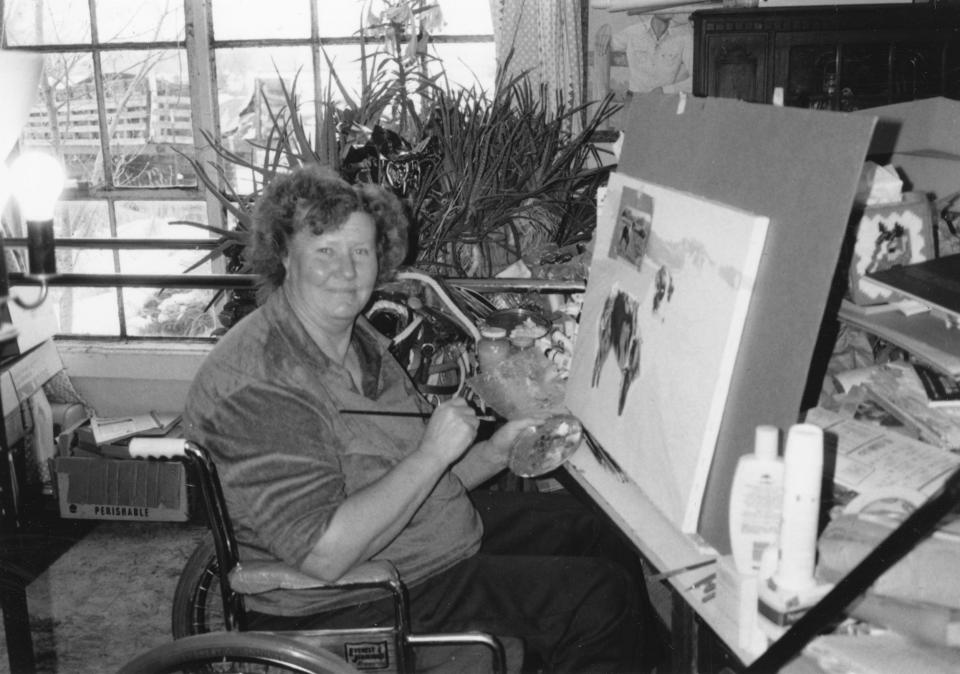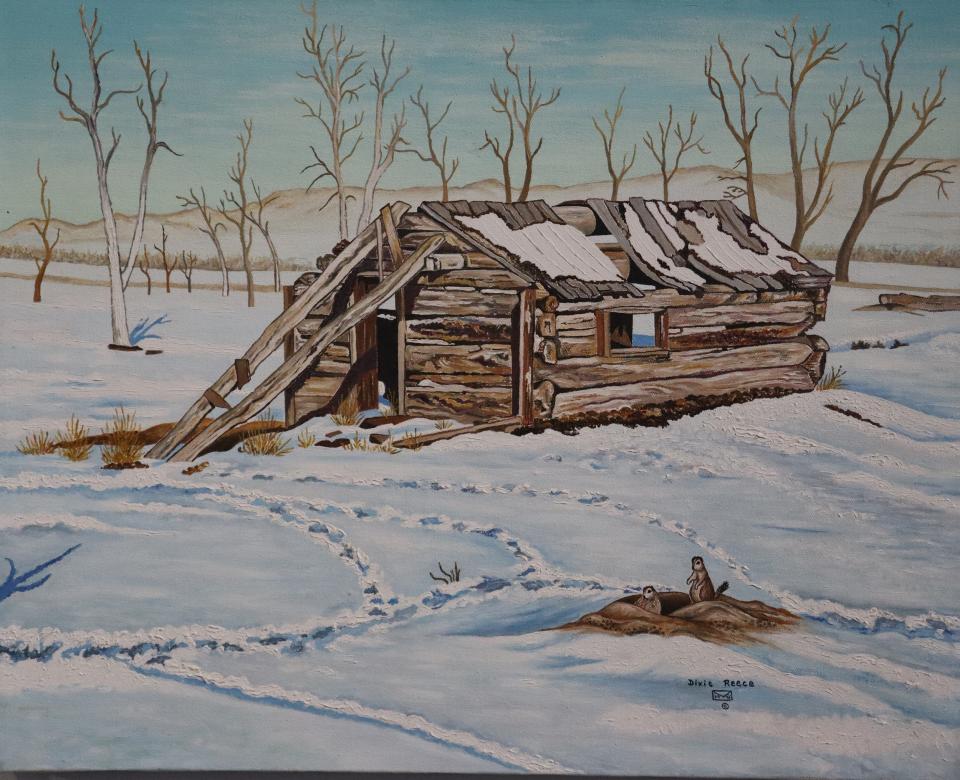No Time for Tears: The Life & Art of Dixie Lynne Reece
By Julie Tachick, Rockpile Museum
Wyoming ranch woman and regional artist Dixie Lynne Reece lived a life of hard work, dedication and courage. From the 1950s-1990s, she seamlessly combined her love of ranching with her joy of painting. The irony of one fateful day — May 16, 1970 — provided both tragedy and triumph for Dixie, greatly impacting her story and artistic legacy.

Dixie was born in the middle of the Great Depression on Feb. 22, 1936. She spent her early years on the family homestead on Twenty Mile Creek, five miles from Echeta, Wyoming, and about 30 miles northwest of Gillette, Wyoming. The Reece family purchased an irrigated ranch along Clear Creek, just north of Leiter, Wyoming, in the fall of 1950, and divided their time between the two ranches.
Art was a lifelong passion for Dixie. As a young girl, she drew what she knew best, western scenes of ranch and rodeo life. After high school, Dixie continued to develop and hone her artistic skills while working the ranch. Her love of Wyoming—the land, wildlife and ranching way of life—inspired Dixie to try painting on canvas around 1958 when she was 22 years old.
Around the mid-1960s, Dixie started to pursue her artwork more seriously. Besides working on paintings for her own enjoyment, she accepted commissions from local friends, neighbors and residents, as well as out-of-state hunters and art admirers. She joined the Campbell County Artists’ Guild and became a member of the Campbell County Cattlewomen’s Cow-belles chapter, designing napkins, banners and fair books for the organization. She also marketed her own line of western greeting cards. Several of her works were featured as cover images for publications such as The Quarter Horse Journal, Golden West, The Paint Horse Journal and Range Country USA. Dixie actively engaged in every opportunity available, and her diligence and perseverance were being rewarded. People liked her artwork. She was making a name for herself.
On May 16, 1970, while gathering cattle for branding, tragedy struck. Things changed dramatically for the Reece family. “My horse jumped across an irrigation ditch and, when it landed on the other side, it bucked…up and off I went.” The fall broke Dixie’s back, severing her spinal cord, resulting in paralysis from the waist down. Following surgery in Billings, Montana, she spent four months at the Gottsche Rehabilitation Center in Thermopolis, Wyoming.
Dixie returned home in a wheelchair. Although she had to learn a new way of life, she was determined to resume her former ranch duties. Hand controls allowed her to drive. She continued to assist with branding, calf tallies, vaccinations and cattle gate checks, while overseeing the ranch books, paying bills, cooking and most of the household chores.
Tragedy is only half the story of May 16, 1970.

The day before Dixie’s accident, her diary entry indicates she submitted four paintings to the Wyoming Art Association for consideration in their 1970 Congressional and traveling show competitions. The Wyoming Art Association chose September Snows as its Congressional winner and the painting would hang in the Washington, D.C. office of U.S. Sen. Cliff Hansen. The award marked a triumph for Dixie on May 16, 1970. She was greatly encouraged and honored by the acknowledgment, and recorded the ironic moment on the back of the work after it returned home: “This painting chosen May 16, 1970 (day artist became parapalegic [sic]) to hang for 1 year in Wyoming Senator Cliff Hansen’s Washington, D.C. office.”
Another accolade followed later that year. In response to her painting of the Nels Martin homestead cabin, the Wyoming State Historical Society recognized Dixie with an award for her promotion of “Wyoming history through the Field of Fine Arts.” Dixie saw the cabin as “a lonely reminder of its builder, a colorful and courageous pioneer in our great American West.” She donated the painting to the Campbell County Museum Board in 1970, before there was a museum building. It was the first artwork of the Campbell County Rockpile Museum and remains part of the permanent collection today.
Dixie was an accomplished western artist before her accident, but her most prolific period of painting followed in the 1970s and 1980s. Local art shows, as well as newspaper articles about her life, provided exposure for Dixie and generated enthusiasm for her art. She kept busy with painting commissions, receiving over 300 in her lifetime. She joined the Buffalo and Sheridan Arts Guilds, and participated in solo and group exhibitions at various venues in Buffalo, Clearmont, Gillette and Sheridan. She faithfully continued to submit work to the Wyoming Art Association, with five paintings being selected during the 1970s to hang in the Washington, D.C. offices of U.S. Sen. Cliff Hansen and U.S. Sen. Malcolm Wallop. Other works were featured in the Wyoming Arts Council traveling show. With dogged perseverance, Dixie secured her largest number of publication covers during this time. The Range Country USA publisher, Robert W. Larson, commended her artwork in the September 1972 issue, stating “We believe that her pictures are some of the most outstanding ever produced in the West, and we are very pleased that we can use them again.”
The events of one day can have a lasting impact. Dixie’s accident did not stifle her creativity, affection for animals or will to live a full life. Instead, it gave her more time for her art. In the years that followed, there were plenty of hardships, but instead of dwelling on them, she forged forward with focus, purpose and a “can-do” attitude until her passing in 2018 at the age of 81. She wrote “no time for tears” on the inside cover of several diaries, perhaps as a reminder to stay resilient. She never looked back, only pushed forward with determination and grit, leaving a legacy of beauty and awe in how she captured the Wyoming landscape, wildlife and way of life she lived and loved.
The exhibition, NO TIME FOR TEARS: The Life & Art of Dixie Lynne Reece, is currently on view through the end of 2023 at The Rockpile Museum in Gillette.
Read more about Wyoming Artists:
An Artist and the Fur Trade: the Wyoming Paintings of Alfred Jacob Miller
Albert Bierstadt: Landscapes of the American West
Jackson Pollock’s Wyoming Links
